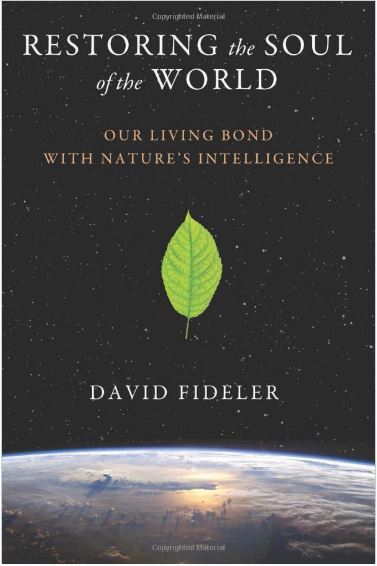 Restoring the Soul of the World: Our Living Bond with Nature’s Intelligence by David Fideler
Restoring the Soul of the World: Our Living Bond with Nature’s Intelligence by David Fideler
Reviewed by David Lorimer
David Fideler’s background is in philosophy and history of science, but he is also a musician sensitive to the wonders and beauty of nature, and he lyrically describes a number of his own experiences in this book. In this respect, he quotes the Greek philosopher Anaxagoras who, when asked why anyone should wish to have been born replied ‘in order to contemplate the heavens and the structure of the world-order as a whole.’ Fideler’s starting point is that, although we have the most advanced technology, we have forgotten what it means to be alive in a living universe. Our mechanistic outlook and focus on objective ways of knowing cut us off from Nature and therefore from a deeper sense of meaning derived from this connection.
The four parts cover awakening to the beauty of nature, the death of nature and the rise of alienation, Anima Mundi and the rediscovery of the living universe, and finally cultivating life in a global community. History makes it clear that the cosmovision or world view of living universe rather than a dead vision has prevailed throughout most cultures. Theory has been balanced with experience and people have sought a harmonious relationship with the cosmos that has also been characterised by a sense of beauty. Science and philosophy have sought unity through understanding form and order. For Plato, the World Soul ‘is the intelligent and harmonious principle of proportion or relatedness that exists at the heart of the cosmic pattern and allows all things to unfold in the best possible way.’ For Alexandrian and Greek philosophers, except perhaps in the abstractions of Aristotle, there is a sense of participation in a larger whole. For Plotinus, ‘we are in a reality that is also within us.’
The author moves on to the themes of mediaeval alchemy where we also find an engagement with living Nature, which Jung defines as transformation itself. Creative decay gives rise to new forms, death leads to rebirth. He contrasts the austere spirit of the desert with the lushness of Earth and quotes the theologian Lactanius who begins to develop the idea of a designer removed from creation. At this point he could have added that this austerity applies to attitudes towards women and the body, and more especially sexuality. There is then some reawakening in 12th century Chartres with an alignment between the World Soul and the Holy Spirit. Thomas Aquinas mentions that beauty requires, wholeness, harmony and radiance. This leads on to Renaissance Florence with the insights of Bruno, Ficino and, subsequently, Paracelsus.
At this point the mechanical philosophy arrives, as developed by Galileo and Descartes leading on to Francis Bacon then Newton. Fideler realises that Newton had an alchemical side to him, but he had to hide his Hermetic interests and expressions of belief in living Nature. Bacon’s philosophy also encourages a spirit of power over and exploitation of Nature, even though he too had esoteric Rosicrucian interests as documented in the work of Peter Dawkins. The next chapter discusses the development of thinking about the unconscious and the importance of the imagination in the work of Goethe, Blake, Schelling and Coleridge. They saw underlying reality of the world not as matter but nonmaterial patterns of relationship and had a keen sense of reciprocity between humans and Nature. Freud was more mechanistic in his understanding but Jung brought back a gnostic and alchemical understanding and a sense of inner connection to the processes of life. More recently, we have the emergence of ecopsychology.
The author moves on to the history of modern science and the reanimation of the universe in our understanding. The determinism of classical physics gives way to fields, relativity and quantum theory, nonlocality, the Anthropic Principle, self-organisation and autopoeisis, complexity and chaos theory, living systems and systems theory, the Gaia hypothesis, symbiosis and synergy. This gives us a completely different cosmovision or world view based on participation rather than the remote detachment of the observer: ‘the universe brings forth life and mind – but life and mind work to shape the universe.’ (p. 219)
This new vision of a living universe can help underpin a revolution on our attitudes to Nature. We also now have the picture of the Earth from space and the mystical experiences of astronauts like Edgar Mitchell. Fideler thinks that three things are needed to live consciously in a Cosmopolis as understood by ancient philosophers: ‘a real, felt sense of our bond with the transcendent order of which we are part; a vision of living Nature and an appreciation of Nature’s intelligence; and an ethical concern for society based on our intrinsic kinship with others.’ (p. 223) In the final part, Fideler describes the contribution of biomimicry towards working with Nature. He discusses the work of John Todd in ecological design and argues, rightly in my view, that sustainability is not enough. We need regeneration. In this context, he could also have mentioned the work of Viktor Schauberger on water and agriculture. At the end, he offers the metaphor of gardening as a constructive human engagement with nature. Work like this is going on, but it is small-scale compared with the overall destructive impact of human activity. As Bede Griffiths also maintained, we do need a new vision of reality to inform our thinking and corresponding action. This book not only provides the necessary background but also the substance of such a vision that now needs to be communicated and acted upon more widely. This in turn implies new thinking about wellbeing that goes beyond the imperative of economic growth, as I discuss below in my review of Love, Fear and the Destiny of Nations.
